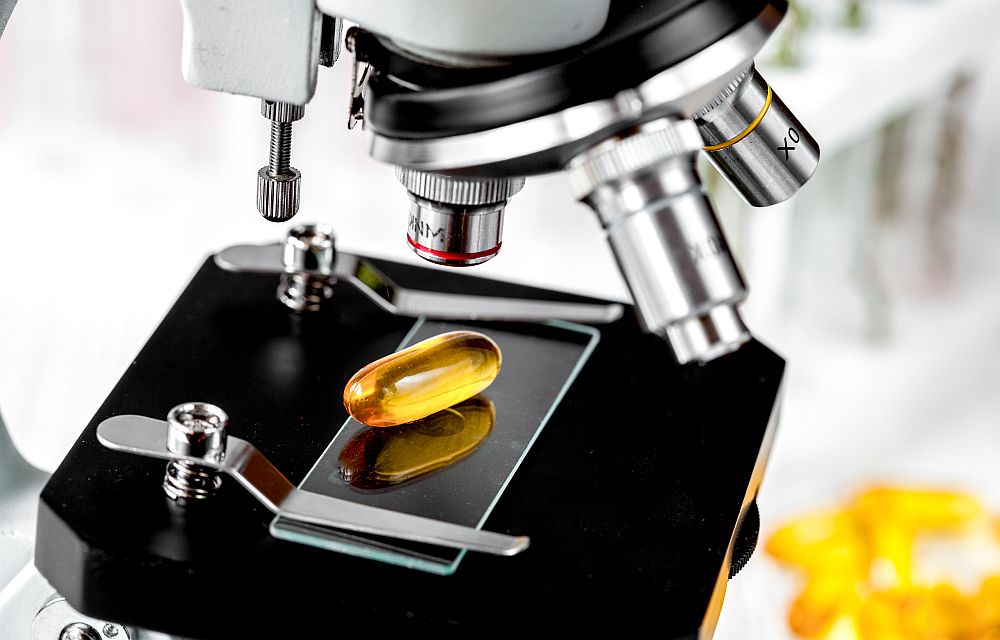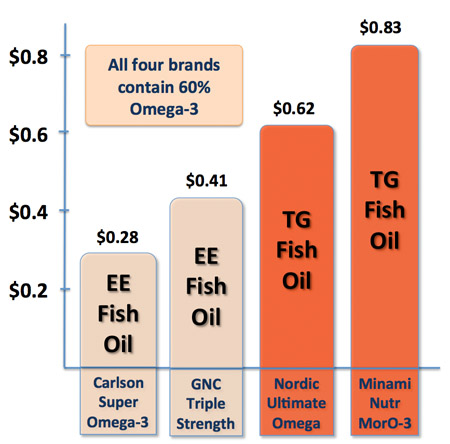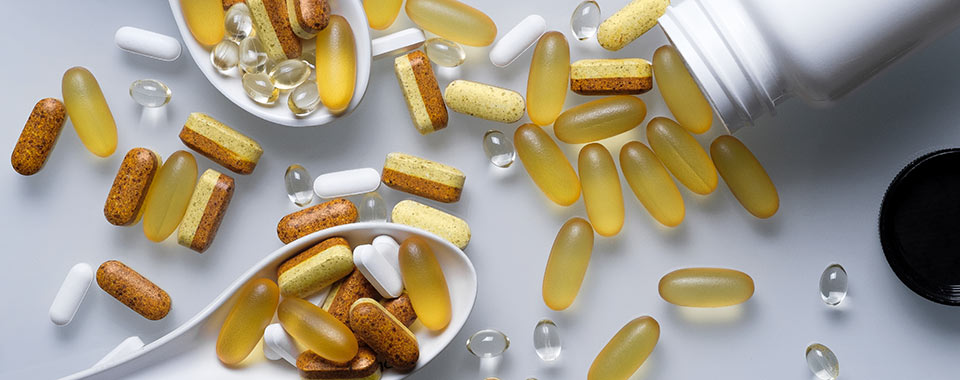In Part 1, we reviewed the scientific evidence of the difference in absorption between EE fish oil and its TG cousin. TG came out slightly ahead.
But…are there any problems with TG fish oil?
Let’s look at some facts:
- True TG fish oil is low in Omega-3, usually 20-30% Omega-3 or less.
- At that concentration, you’ll have to take almost a dozen pills a day to get enough Omega-3 for reducing your blood triglycerides.
- Concentrated TG fish oil (also called rTG) supplements are are not cheap.
- A lot of the scientific research to date (more than 18,000 scientific papers) has been performed using EE form of fish oil.
Besides the increased cost and large number of pills required, there are no valid reasons to avoid TG fish oil. If you’re on a tight budget and need 3,000 mg of Omega-3 per day, rTG fish oil may not be cheap.
OmegaVia used to contain EE form of fish oil it was changed to rTG form in 2016.
Internet and Emails as a Scare Tactic!
A lot of internet marketing and advertising chatter will have you believe that EE fish oil is pure poison! One drop and you’ll fall flat on your back. Time to meet your maker!
Not so fast, Skippy!
Moderation and common sense does not get much attention these days.
There are a lot of people (and brands) on the internet spreading fear about EE fish oil. I think this is predatory and self-serving.
SCARE TACTIC #1: Your kids will get intoxicated!
One of the points used to stir up fake-fear is alcohol.
When a molecule of EE fish oil is metabolized by your body, a molecule of alcohol is released. A teeny, tiny bit.
A daily dose of EE fish oil has about as much alcohol as a glass of orange juice. Yes, all fruits and juices have a tiny bit of alcohol in it. Nothing to worry about – your body is built for and perfectly capable of handling fruits as well as EE fish oil.
But if you believed everything you read, you’d think that little children all over the country are passing out drunk from taking a little EE fish oil!
SCARE TACTIC #2: Styrofoam Cup Parlor Trick
This is my favorite!
There is a YouTube video of someone putting ethyl ester oil in a styrofoam cup. The oil, naturally, melts through the cup. The demonstrator looks up at the camera in mock shock!
It makes for great entertainment, but the only thing it proves is what they taught me in Chemistry 101, that compounds with similar polarity attract and often dissolve each other. Unless your digestive system is composed of polystyrene, there is absolutely nothing to fear! Until then, the styrofoam cup video is a great parlor trick.
Ironically, in Asia, where they sell mostly low-potency oils, they use reverse-styrofoam-melting-trick…in other words, their advertisers are telling people that good and strong fish oils SHOULD dissolve styrofoam cups and one SHOULD ONLY BUY oils that do so.
I got this email from a customer in Malaysia, just 2 days ago:
“We see lots of demonstrations using polystyrene food box. One will cut the fish oil capsule into half letting the oil drip onto the box. Oil that ‘burns’ a hole through the box is claimed to be of the highest purity. What do you make of such claim? Is there any scientific truth there?”
These demonstrators do not understand chemistry and are hoping you’ve forgotten it since high school. If I were really cynical, I’d say that they know their chemistry, but are betting that you don’t!
SCARE TACTIC #3: Yikes! EE fish oil is banned in some countries!
Easy there, Skippy! Not so fast!
Japan and some EU countries distinguish over-the-counter supplements and pharma drugs. Supplements are TG fish oils. And pharmaceutical drugs are EE fish oils.
Simple rule. Keeps the kids from fighting.
Japan has had a high-EPA prescription fish oil drug in EE form for two decades. It’s sold as Epadel.
US regulations allow for EE fish oil to be sold as BOTH prescription and OTC supplements.
Why all the scare tactics?
Profit.
And the competition is stiff.
Using fear as a selling tool is an age-old trick. Politicians do it every day! Need I say more?
Why did we use EE fish oil? (And why we switched to Triglyceride form)
Simple. We used EE because allowed for ultra-concentration of Omega-3.
TG fish oils contain 20-30% Omega-3 and cannot be concentrated.
If you want Ultra-concentrated fish oil, you need to concentrate the oil to 80 or 90% Omega-3. EE fish oil can be concentrated to high strength. TG fish oil cannot.
This concentration allows you to take fewer pills and yet get all the desired benefits of fish oil.
After all, what’s the point in taking fish oil if there isn’t enough Omega-3 in it?
Omega-3 delivered to your body in either form, EE or TG, eventually ends up in your cell membranes, where they go about doing the wonderful things they do.
EE still does the job – pancreatic lipase hydrolyses EE to a slightly less degree than TG. And at a slightly slower rate. You won’t feel the difference.
Addendum: We did the above for 6 years. But in 2016, we switched to Triglyceride (rTG form) because consumers increasingly began asking for it, thinking it was safer. The power of negative marketing worked and the market shifted. Even though the current rTG oil is more expensive, we’ve kept the retail price the same as before.
What’s rTG Fish Oil? Even more science!
Some companies now go a step further…
They start with 30% Omega-3 TG fish oil. Then convert it to 60 or 70% Omega-3 as EE fish oil. Remember, you can only concentrate fish oil in the EE form.
And then, enzymes are used to re-esterify the Omega-3 fatty acids back into the TG form. This process is called enzymatic glycerolysis. These oils are called rTG in the fish oil industry.
It’s a fancy way of getting high concentration, yet be able to say that the oil is in its ‘natural triglyceride’ form.
Is rTG better than TG?
Yes. A little.
A recent 2-week study by Dyerberg et al., did something, ummm…interesting, in my opinion – they indexed the results. Instead of comparing all fish oil results to placebo, they compared EE and rTG to regular fish oil. While this might seem harmless on the surface, it exaggerates the facts. It makes the difference between TG and EE APPEAR bigger.
Some call it funny math.
I’m not the only one who found this a little odd…
“How they reported the results was instead of comparing the results to placebo, they took the position of comparing the other forms to regular fish oil and cod liver oil, “as if” regular fish oil and cod liver oil were “the standard” by which to compare the others. With this approach, the re-esterified TG concentrate form improved blood levels better than regular fish oil and cod liver oil, and the result of consuming the EE concentrate on blood levels was less than regular fish oil and cod liver oil.”
– Gretchen Vannice, MS, RD – Omega-3 Dietitian in Comments on recent studies comparing TG and EE forms of fish oil
Like I said, funny math. Using this funny math, rTG is 70% better than EE. I’ve seen websites that claim 120-something percent better. Skippy strikes again!
Funny Math & TV CommercialsTangentially, this funny math is used to market cholesterol (statin) drugs. If people on placebo had a 1% decrease in cardiac events and people on stains had a 1.5% decrease, that HALF PERCENT difference will be conveniently interpreted as (1.5-1/1.5) = 33%. Before you know it, there is a TV ad that says statin drugs reduce your risk of cardiac events by 33%. Very clever! This has actually happened! |
The Neubronner study was longer, more robust and much more conclusive in comparing the Omega-3 Index (see Part 1) of TG vs EE.
At the end of their study, they got the participant’s Omega-3 Index up from 7 to 12.2 for the EE group and 13.2 for the TG group. That about 15% difference. Let’s be generous and say 20%. Super generous = 25%. That’s still far from the 70% that marketers of TG oils like to claim.
Regardless, if you can get your Omega-3 Index above 12, you should be jumping up and down! And EE fish oil clearly did so in this very well designed study. Nuff said.
Cost difference between EE and TG (or rTG)?
A big cost difference.
Concentrated TG oils (rTG) are expensive.
If you buy fish oil by the truckload, like we do, there is roughly 40% premium for TG oils. That usually translates to twice the cost for you, the consumer.
There are very few well-known TG fish oil brands. Nordic Naturals Ultimate Omega and Minami Nutrition MorO-3 come to mind. Both are excellent products. I recommend them without hesitation.
They are both rTG products, which are usually about 60% Omega-3 potency. The following is a comparison of these two products with a couple of other mid-grade fish oils.
Prices verified in January 2012 and may have since changed.
As a comparison, OmegaVia costs about as much as the GNC Triple Strength Fish Oil.
The bottom-line remains…
Are you willing to pay almost twice as much for far less than twice as much absorption?
Once you dispense with the shady marketing, you are left with two slightly different products that give you the same health benefits. Generally speaking, the strongest EE oils contain 20 to 30% more Omega-3 than the strongest TG oils. This makes the absorption claims somewhat of a wash.
Unless major new clinical evidence changes the scientific landscape, it’s a no-brainer to me.
I’m sticking with EE fish oil.
And I eat salmon frequently and avoid Omega-6-rich vegetable seed oils.
*These statements have not been evaluated by the Food and Drug Administration. This product is not intended to diagnose, treat, cure, or prevent any disease.





I usually buy the brand that has 1000mg in it. I didnt notice what kind of fish oil. I know it is from small fish. I think it is Blackmores.
Vin, I was viewing the Nutrigold website and its commentary on two other omega-3 products which it manufactures, one in the ethyl esters form and one in the triglycerides form. See, http://www.nutrigold.com/Triglyceride-Omega-3-Fish-Oil.)
For the purposes of this discussion, precisely why Nutrigold decided to manufacture two different forms of omega-3 is not important, although I am curious about it. What I think is more on point is the way Nutrigold commented upon both types. Here’s what Nutrigold said:
“Most fish oil supplements are either available in Ethyl Ester form or the Triglyceride form. Structurally, the major difference between the two forms is that in Ethyl Ester, the fatty acids (EPA & DHA) are esterified to an ethanol backbone, while in TG, the fatty acids are esterified to a glycerol alcohol backbone; there are absolutely no differences in the two forms of fish oil in terms of stability. The vast majority of clinical studies examining supplemental Omega-3s have been performed on the Ethyl Ester form and results from studies comparing the relative bioavailability of the EE form versus the TG form have found increased bioavailability of the TG form in the short-term (2 weeks), but this difference disappears when fish oil is routinely supplemented and a steady state has been achieved over a longer period of time.
The scientific evidence currently available does not point to any significant differences between the two forms in terms of bioavailability or health benefits when taken over extended periods of time (which is the norm for most individuals) and the decision to supplement with the TG form versus the EE form is, in most cases, a matter of personal preference.”
I find the foregoing interesting when trying to figure out the difference between the two forms, i.e., which might be better and why.
According to Nutrigold, It would appear that the difference between the two forms, from an “effectiveness” point of view, is that it is a distinction without a difference.
Taking Nutrigold’s comments at face, there are only two remaining issues: (1) cost to the consumer, and (2) potency, where it appears that the ethyl esters form is generally less expensive and more potent.
Any thoughts or comments?
Hi RWM – as mentioned earlier: I don’t see quite 100% eye-to-eye with the quotes from Nutrigold, but they share my general opinions. If TG and EE oils are exposed to light, heat and metals, EE oils will oxidize a little faster. TG is a little more stable. But this is why most fish oils pills are kept from air, light and metals. This makes a big difference with liquid fish oils – that’s why most are TG.
You’re right, it ultimately comes down to cost to consumer and potency.
To say ‘it is a distinction without a difference’ is fair in my view. But I suspect TG proponents would strongly disagree.
– Vin Kutty
This may be a bit off topic, but why do you think any company would manufacture both forms of omega-3, the ethyl esters form and the triglycerides form, given the heated debate on the topic? Could it be they are trying to cover all their bases, or is it a tacit acknowledgment that both forms are fine, but for different reasons?
Yup – covering all bases.
Hi Allyanna – kudos to you for becoming aware of leaky gut! Millions of people don’t even know they have this problem. You have my best wishes.
As far as EE vs TG for leaky gut, it makes no difference. There is NO EVIDENCE that says one is better over the other for leaky gut and the argument does not pass my sniff test. If you eat EE fish oil with meals, it is virtually the same as triglyceride form. And EE is certainly best for your money.
Enteric coating is better for people with inflammatory digestive conditions. Leaky gut isnt Crohns etc. so there may not be an advantage for you either way.
🙂
No difference whatsoever, Denise. While Omega-3 use will ‘streamline’ your body’s fat burning, using Omega-3 as a weight loss tool is certain to fail. A better starting place for weight loss may be to eliminate all sodas, soft drinks, sports drinks, juices and processed foods. Adding Omega-3 supplements (EE or TG) will definitely help get healthier.
Thank you for posting this information. It was very informative and believable.